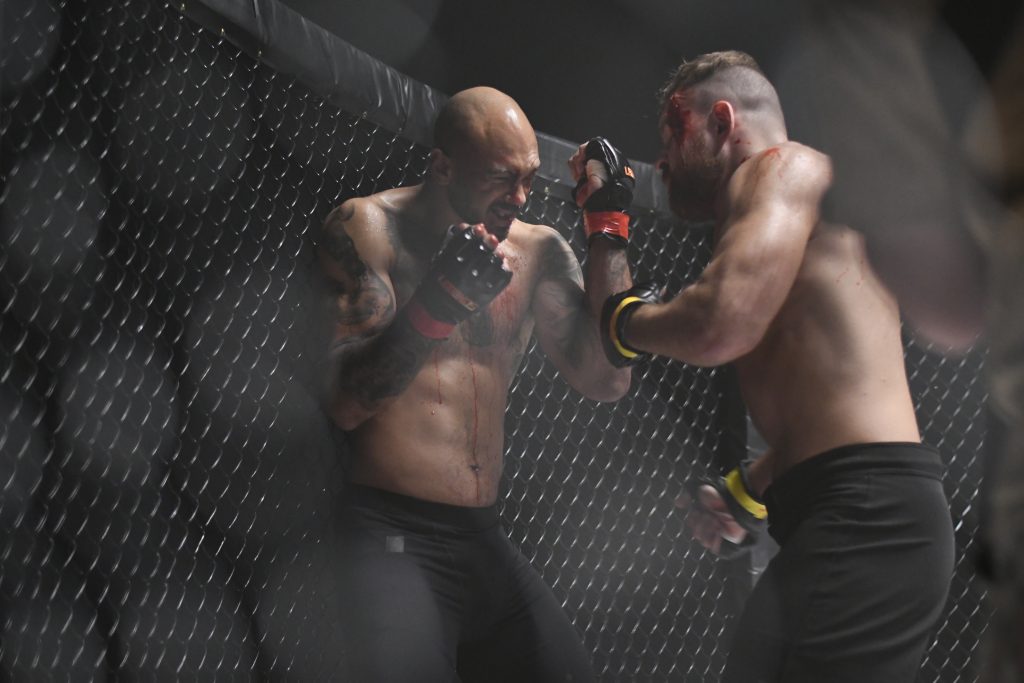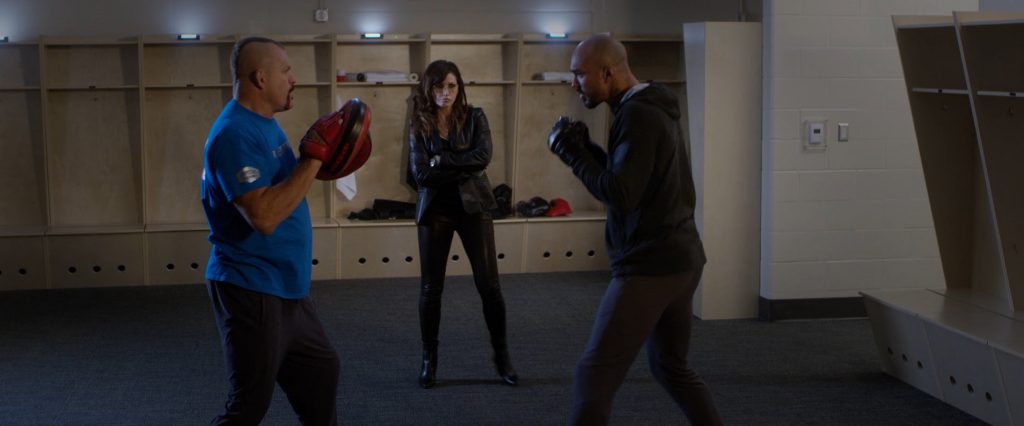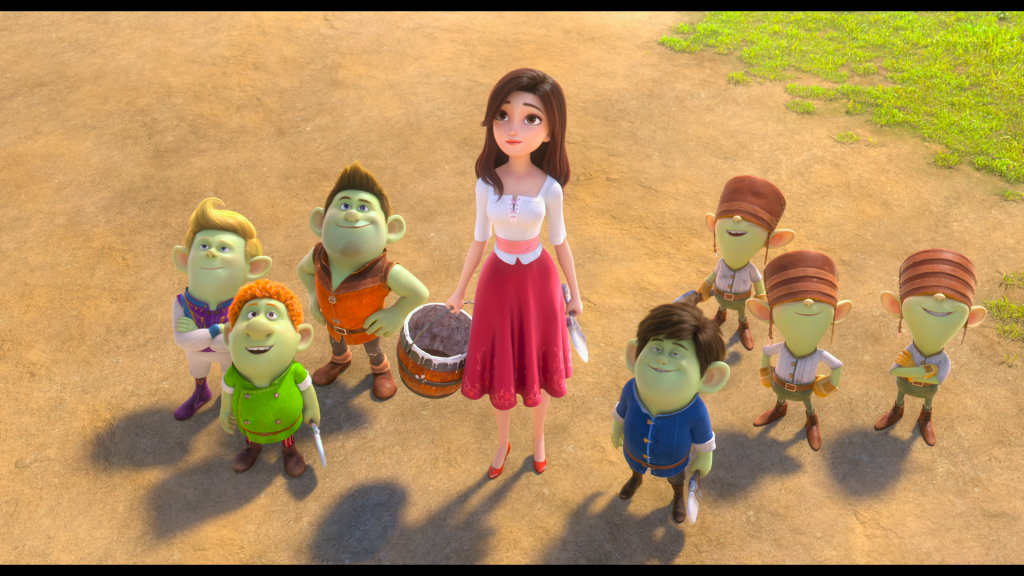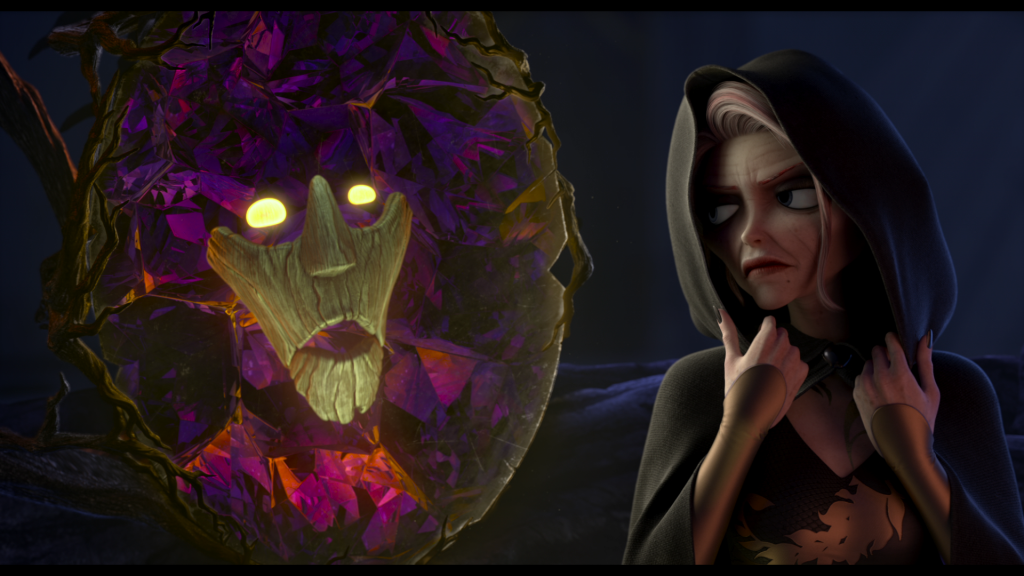November 15, 2023
by Carla Hay

Directed by Eli Roth
Culture Representation: Taking place from 2022 to 2023, in Plymouth, Massachusetts, the horror film “Thanksgiving” features a predominantly white cast of characters (with a few African Americans, Latin people and Asians) representing the working-class, middle-class and wealthy.
Culture Clash: A mysterious serial killer, who’s disguised as Plymouth pilgrim John Carver, gets revenge on people who directly or indirectly caused the deaths of people during a Black Friday riot at a Walmart-type store.
Culture Audience: “Thanksgiving” will appeal primarily to people who are fans of filmmaker Eli Roth and slasher horror movies that skillfully mix comedy with suspenseful mystery.
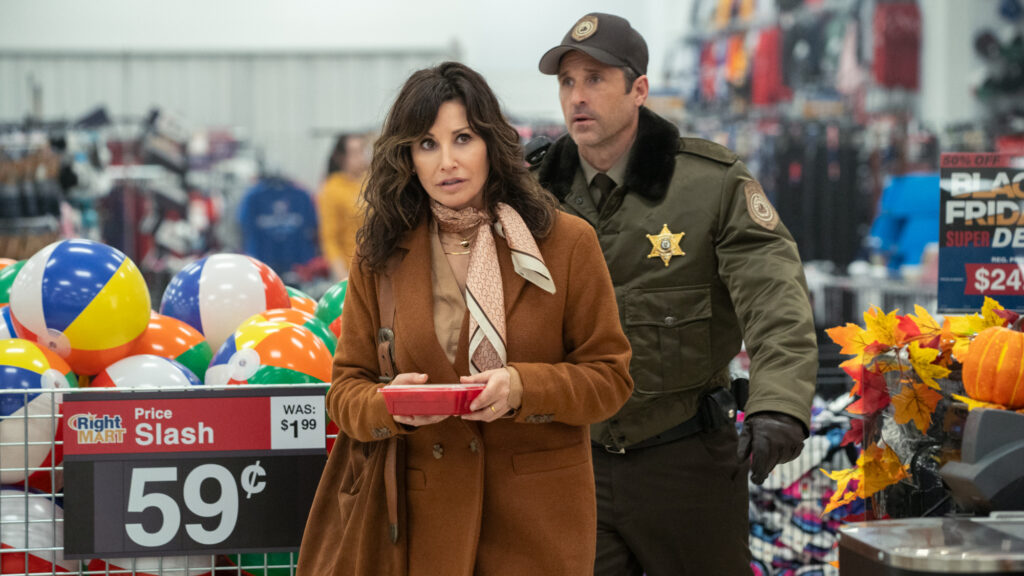
“Thanksgiving” offers a satisfying menu of unique terror scenes, whodunit suspense and laugh-out-loud comedic moments. It’s an instant classic for holiday-themed horror movies. This movie is not for people who get easily squeamish by violent gore.
Directed by Eli Roth and written by Jeff Rendell, “Thanksgiving” takes place in Plymouth, Massachusetts, a municipality famous for being the site where the Mayflower Pilgrims colony was founded in 1620. The Mayflower Pilgrims were among the first to celebrate Thanksgiving (a day to give thanks for good fortunes and blessings), which became a national holiday in the United States. Thanksgiving is celebrated in other countries too, but the Mayflower Pilgrims story is part of U.S. history.
It’s no wonder that Thanksgiving has a special meaning for Plymouth. But in the “Thanksgiving” movie, Plymouth will be the target of terror by a serial killer dressed as a Thanksgiving pilgrim. (“Thanksgiving” was actually filmed in the Canadian cities of Hamilton and Port Perry, Ontario.) The movie takes place during the Thanksgiving holiday season within a two-year period.
“Thanksgiving” opens with a seemingly harmless sequence of two very different households celebrating Thanksgiving Day in 2022, with traditional gatherings for Thanksgiving dinner. The Collins family has a middle-class household consisting of spouses Amanda Collins (played by Gina Gershon) and Mitch Collins (played by Ty Olsson), who works as a manager at a general discount store called Right Mart. (It’s very similar to Walmart.) Mitch has to work that night to prepare for the midnight opening of Right Mart for the Black Friday sales. Family friend Sheriff Eric Newlon (played by Patrick Dempsey) is a bachelor who has been invited to this Thanksgiving dinner, which includes a few other relatives in the Collins family.
The other household is that of the wealthy Wright family, whose patriarch Thomas Wright (played by Rick Hoffman) owns the retail chain called Right Mart, which is very popular in Plymouth. Right Mart is so popular in Plymouth, a crowd of about 100 people have gathered on Thanksgiving night in the parking lot of Right Mart, so that they can be the first people let into the store at midnight, when Right Mart will open to have a massive Black Friday sale.
The Collins household is festive and upbeat for Thanksgiving. By contrast, the Wright household has a lot of tension. That’s because Thomas’ teenage daughter (and only child) Jessica, nicknamed Jess (played by Nell Verlaque), disapproves of her stepmother Kathleen (played by Karen Cliche), because Jessica thinks Kathleen is an opportunistic gold digger. It’s mentioned in conversations that Jess’ mother is deceased. Thomas and Kathleen had a quick courtship and engagement before getting married. Jessica is about 16 or 17 years old in the beginning of the movie.
“Thanksgiving” introduces a few too many characters in the beginning of the film, particularly when it comes to Jessica’s social circle of friends at her high school. Jessica’s boyfriend Bobby DiStasi (played by Jalen Thomas Brooks) is a star pitcher on the school’s baseball team. He has the nickname Golden Arm because of his pitching talent. Other people who hang out with Jessica are two couples who attend the same school: rebellious prankster Evan Fletcher (played by Tomaso Sanelli); Evan’s fun-loving girlfriend Gabby (played by Addison Rae); friendly athlete Conrad Scuba, nicknamed Scuba (played by Gabriel Davenport); and Scuba’s cheerleader girlfriend Yulia (played by Jenna Warren), who also comes from a wealthy family.
On the fringes of this clique is McCarty (played by Joe Delfin), a scummy guy in his 20s who sells drugs and guns, often to teenagers. McCarty is somewhat known in the area for having a big annual party (called the McCarty Party), on a night close to the Thanksgiving holiday. Another prominent character in the movie is Ryan (played by Milo Manheim), an academically talented student who has a crush on Jessica and tries to get to know her better, even though Ryan knows that Bobby is her boyfriend.
What happens at the Right Mart in Plymouth will become a violent tragedy. Tensions are running high in the crowd of people who are anxious for the store to open for Black Friday. There’s a barricade separating the crowd from the store, but there is no orderly line for this crowd, which is one of the first signs that things might go wrong. Some people standing close to each other start to have petty arguments when they think someone else is trying invade their personal space. One of these argumentative people is a loudmouth named Lizzie (played by Amanda Barker), who is one of the more aggressive people in the crowd.
Somehow, Jessica’s friends convince her to take advantage of the fact that her father owns Right Mart, because Jessica has access to the master key to the store. Evan is the one who comes up with the idea to go into the store before the crowd can be let in for the Black Friday sales. The people outside can see what’s going on inside store through the long glass windows at the front of the store. Jessica and her pals go in the store, where Evan and a few of the others taunt the bystanders outside by appearing to be shopping inside.
This sight enrages many people in the crowd. One of the bystanders grabs a megaphone from a security guard and shouts that the store is now open. And that’s when all hell breaks loose. People rush through the barricade and crash through the front doors, with many people trampling one of the only two security guards who was in front of the store. This unlucky security guard’s name is Doug (played by Chris Sandiford), and he will be talked about several times later in the movie.
The customers in this mob scene start to act like violent looters. An unexpected arrival at the store is Amanda, who is at Right Mart to surprise Mitch with some leftover Thanksgiving food. Amanda is one of the people who gets physically injured during this chaos. The mayhem becomes such an emergency, Sherrif Newlon is called to the scene. He becomes the lead investigator in the case. At least two people die in the pandemonium. It’s a very gripping way to begin the movie.
“Thanksgiving” then fast-forwards to a year later. Right Mart’s video security footage from the Black Friday tragedy has mysterously gone missing. And so, videos that people took on their phones are what most people see of what happened in the store on that fateful night. The video that Evan took is one of the biggest viral videos out of all the videos from that night that got attention from the media and the public.
TV news reports show that there is controversy in Plymouth because Right Mart owner Thomas wants to do the same Black Friday promotion as the previous year. This decision has gotten criticism from many people who think Right Mart should be closed on Black Friday, out of respect for the people who were hurt or died in the chaos in the previous year. One of the protestors is Mitch, who no longer works for Right Mart. Thomas remains unmoved by the protests, and he refuses to change his decision.
A TV news report on the one-year anniversary of the tragedy mentions that Bobby’s injuries in the melee ended his promising baseball career. Bobby left Plymouth shortly after the Right Mart tragedy and disappeared. However, Bobby suddenly shows up in Plymouth again, close to the one-year anniversary of Right Mart’s deadly Black Friday fiasco. Bobby is apologetic to Jessica for leaving and cutting off all communication with her.
Jessica forgives Bobby, but she has a new boyfriend: Ryan, who isn’t happy to see that Bobby has come back to Plymouth. Ryan and Bobby dislike each other immensely. Their rivalry over Jessica becomes a subplot in the movie.
It’s a Wright family tradition to film themselves for a Right Mart TV commercial. This year, they will be filming the commercial at a local landmark called the John Carver House, which is named after the first governor of the Plymouth Colony. When the Wright family arrives at the house, they see that it has been vandalized. Thomas notices that an ax that had been hanging on the wall is missing.
And you know what that means. Shortly after this theft and vandalism, Jessica and her friends start getting bizarre text mesages from someone who is using the name The John Carver. The messages have photos attached that show a dining table with Thanksgiving decorations. “The table is set,” the first message reads.
The rest of “Thanksgiving” is a wild ride of scares and some laughs. It should come as no surprise that the killer (who is disguised as John Carver during the murder spree) is seeking revenge against people whom the killer blames for the Black Friday tragedy that happened at Right Mart. Some of the movie’s murder scenes are inventive and very gruesome. Hint: You might never look at trampolines the same way again after seeing “Thanksgiving.”
The performances in the movie get the job done well enough for a horror flick. Even in this fairly big ensemble cast, Verlaque naturally stands out, because the story is told mostly from the perspective of Jessica. Delfin also gives a memorable performance as the sleazy McCarty, who is supposed to be some of the movie’s comic relief.
“Thanksgiving” will keep viewers guessing on who’s behind all these murders and the details of the revenge motive. The identity of the killer is a lot easier to guess than the motive. (An end-credits scene looks like a comedic outtake from the movie.) There’s an obvious hint of a sequel, which will no doubt be expected, since “Thanksgiving” is the type of movie that will quickly win over horror fans who want to see this story continue.
TriStar Pictures will release “Thanksgiving” on November 17, 2023.



